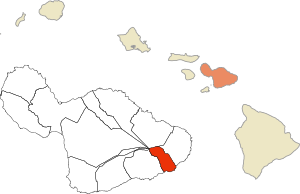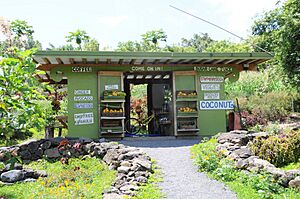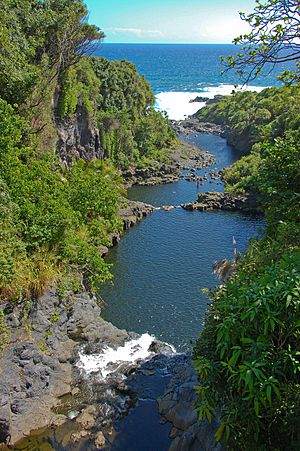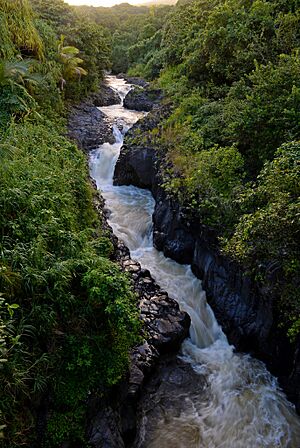Kipahulu, Hawaii facts for kids
Quick facts for kids
Kīpahulu
Kīpahulu
|
|
|---|---|

Ancient district of Kīpahulu
|
Kīpahulu is a small, quiet community located in the Hāna area of southeastern Maui, Hawaiʻi. It's not a city or town, but rather an "unincorporated area," meaning it doesn't have its own local government.
Contents
Where is Kīpahulu?
Kīpahulu is found south of Hana and east of Kaupo. Imagine a map of Maui; Kīpahulu is nestled on the southeast side.
Getting Around Kīpahulu
There are two main ways to reach Kīpahulu by land. You can drive from the north on the Hana Highway, which takes about 45 minutes past Hana. Or, you can come from the west on Highway 31, also known as Piʻilani Highway. This highway is the main road in Kīpahulu, and most of the homes and buildings are located along it.
Life in Kīpahulu
Life in Kīpahulu is a bit different from most places. The community does not have public electricity or water systems. The only public service available is telecommunications, like phone and internet. People get their water from streams that flow down from Haleakalā volcano. Private companies provide these essential services to the residents.
Kīpahulu's Past: A Look Back
Kīpahulu has a rich history. The first time it was written about was in 1786 by a French explorer named Jean-François de Galaup. He was sailing along Maui's coast and described seeing many waterfalls and a large number of people living close together. He said it looked like a single big village stretching for miles.
Early Visitors and Villages
Long ago, the lowlands of Kīpahulu were home to many people. There were hundreds of farms and special terraces built into the land for growing crops. Kīpahulu was once a very important area, serving as the center of one of the old land districts called moku. When experts surveyed the coastal areas, they found over 700 old features like stone mounds, walls, and earth terraces. These show how people lived and farmed there centuries ago.
Coastal villages were made up of groups of homes for extended families, known as ʻohana. These homes included places to live, cook, and sheds for work or storing canoes. Other simple dwellings were located higher up in the farming areas, used when people were working in the fields. All the buildings were single-story, made of wood frames with thatched walls and roofs. Small stone shrines were also part of these village sites.
Changes Over Time
In the 1880s, the whaling industry became very important on Maui. Many people from Kīpahulu started moving to bigger whaling ports like Lahaina. This caused Kīpahulu's population to get smaller.
In the early 1900s, Kīpahulu was a regular stop for steamships. These ships carried passengers and goods around Maui and to other islands. Kīpahulu Landing was a busy place where farmers and ranchers could ship their products to markets. Today, Kīpahulu Landing is private land and is protected by The Nature Conservancy, an organization that works to save important natural areas.
The main highway in the area was closed for two years, from 2006 to 2008, because of damage from an earthquake.
Important Places in Kīpahulu's History
You can find the grave of the famous aviator Charles Lindbergh on the grounds of Palapala Hoʻomau Church in Kīpahulu.
Exploring Haleakalā National Park
Haleakalā National Park became its own national park in 1960. Before that, it was part of a larger park that included areas on Hawaiʻi Island. The park first only included the crater area of Haleakalā volcano. Later, in 1951, Kīpahulu Valley was added to the park as the Kīpahulu Biological Reserve. This was done to protect special and endangered plants and animals. Then, in 1969, the park grew again to include the Kīpahulu coastal area known as ʻOheʻo.
The 'Ohe'o Pools and Trails
Most of the Kīpahulu Biological Reserve is only for researchers and park managers. However, the ʻOheʻo part of the park is open for everyone to enjoy! A popular spot here is the ʻOheʻo Pools, which many people call the "Seven Sacred Pools." It's important to know that swimming is not allowed in these pools to protect the natural environment.
If you want to stay overnight, there's a campground that you can reach by car, but you need to make a reservation. For those who love hiking, the Pipiwai trail is a great choice. It leads to the beautiful Waimoku Falls, which are 400 feet tall!
Learning About Hawaiian Culture
The Kīpahulu ʻOhana is a non-profit group that started in 1995. They work with the national park to bring back, restore, and share the traditions of Native Hawaiian culture. They also offer cultural tours, where you can learn more about the history and ways of life of the Hawaiian people.
Protecting Kīpahulu's Forests
The Kīpahulu Forest Reserve was created on August 20, 1914. Its main purpose was to protect the important watersheds and streams. These streams provided water for local loʻi kalo (taro farms) and the Kīpahulu Sugar Plantation. Today, the Hawaii Division of Forestry and Wildlife manages this reserve.
The reserve covers about 2,389 acres on the side of Haleakalā that faces away from the wind. It was originally one big area, but some parts were removed over time. Now, it's made up of four separate sections. The main focus of management is on the largest section, called Naholoku. The other three sections are smaller and sometimes hard to reach.
See also
 In Spanish: Kipahulu (Hawái) para niños
In Spanish: Kipahulu (Hawái) para niños




